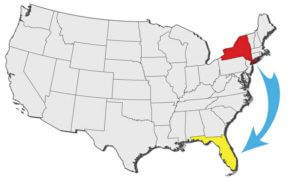Moving to Florida from NY - Costs, Insurance, Tips & More
Whether you’re located in NYC, the Hudson Valley, or scattered across Upstate New York, relocating to Florida might feel like a dream come true. After all, when New Yorkers are out shoveling snow during February, it’s a balmy 70 degrees in Miami!

Moving to Florida from NY has some serious advantages beyond sandy beaches and warm weather. Florida offers a lower cost of living, lower taxes, and no state income tax.
It’s also a common goal for Northeasterners. According to the US Census Bureau, around 65,000 people moved to Florida from NY in 2017. Migrations to the Sunshine State are regularly the biggest contributing factor to Florida’s influx in population.
But, while becoming a Floridian might sound great, relocating over such a tremendous distance can be a real hassle. It’s possible to rent a moving truck and do everything by yourself, but facilitating a long-distance move isn’t easy. That’s why many migrating New Yorkers turn to a moving company for help.
This guide will tell you everything you need to know about moving to Florida from New York so that you know what to expect.
Let’s jump right in!
Table of Contents
ToggleNY to Florida: Average costs
Your relocation costs depend on a variety of factors.
It’s almost always cheaper to move yourself rather than hiring professional movers, but the logistics involved make this impractical for most people.
While renting a truck from your local U-Haul may cost anywhere from $2,500 to $3,000 (average cost), you’ll still need to account for the time and cost it takes to pack your items, load the truck, and relocate to your new home.
On the other hand, a full-service move — including packaging, shipping, and unpacking — can cost thousands in labor fees and moving costs.
Typically, moving companies will request an estimate on the number of items that you intend to move. This defines most of the costs and pricing you’re likely to see throughout your moving experience.
If you’re uncomfortable with trying to inventory your own home, your moving service may be able to help. Traditionally, estimating costs included an in-home visit, where your movers could get a better understanding of the work involved.
Since the COVID-19 coronavirus pandemic, Your Hometown Mover and other moving companies have implemented Live Video Estimates, where a live operator will guide you through the steps required to inventory the items in your home.
On average, it’s very uncommon for a long-distance move to cost less than $5,000, and moving a fully furnished 10,000 sq. foot house over a long distance could easily run upwards of $10,000.
Ultimately, you’ll need to determine your budget for the move, whether you’re willing and able to do the heavy lifting, or if you should get help from professional movers along the way.
Keeping costs low
If paying thousands of dollars for a full-service move just isn’t your style, you may have a few options to lower costs prior to committing to the move.
Price matching
If you can find affordable movers, price-matching options might be available with other reputable services. With a little research, you could potentially save thousands of dollars in moving costs.
To take advantage of this, you’ll need to secure a quote from movers in your area. Most moving services offer a free quote or estimate based on where you’re planning to move and what you plan to take with you.
The quote needs to make sense for your situation. For example, if you live in New York City and you want to move to Orlando, a quote covering costs from Buffalo to Tampa won’t help. Get a quote that is as accurate as possible by providing good information and allowing the company to make an honest assessment.
From there, you’ll need to find a mover that offers price matching and check to see if they can match the rate.
Moving labor and packaging services
You might be able to split the cost between professionals and DIY if you’re willing to handle some parts of the move by yourself.
If you’re comfortable driving the 1,500-mile journey to Florida from NY, you could pay for the moving labor and services you need and take care of the move yourself. This is a great service for able-bodied New Yorkers who need help loading and unloading but who are otherwise comfortable with a road trip down the East Coast.
Some moving companies offer services by the hour in order to handle specific aspects of a move. If you’re on a budget and willing to do some of the work yourself, this is a good middle ground to consider when estimating costs.
Your Hometown Mover offers particle services to help you get started. Explore our packing services and moving labor options to learn more.
Financing options
Occasionally, you can find financing options available for full-service moves. These “move now, pay later” options allow you to finance the cost of your move over a set term and pay it back with a small amount of interest.
Unfortunately, these options are very limited and have become even more scarce with the COVID-19 pandemic.
Transit times
New York and Florida are roughly 1,000 miles apart, with moves to south Florida locales like Miami Beach and Key West even farther away.
Because of the distance and the labor involved, most moving companies will estimate delivery between 7 and 14 business days from the day of pickup.

This happens because many traditional moving services will take the contents of your move to a warehouse after they pick it up. From there, your shipment is combined with others bound for the same destination in order to reduce costs.
While this is an effective (and profitable) strategy for the moving company, it also adds an additional lead time to your relocation.
What about expedited delivery?
Don’t want to wait to escape the big city and start enjoying the great weather? Ask your moving service provider about expedited delivery options.
Typically, expedited delivery offers a turnaround time of 1 to 3 business days. When moving to Florida from NY, you should expect a slight extension in your delivery time due to the distances involved.
With expedited delivery, your shipment skips the traditional warehousing consolidation that takes place with a standard delivery. After your goods are picked up, they will be driven straight to your Florida home.
As you might expect, while expedited delivery is faster, it’s also more expensive. Be sure to clarify these costs with your shipper before you commit to them.
Shipment tracking
Unlike a local move, where you often know the exact location of your shipment at all times, long-distance moves are more complicated due to the time and distance involved.
![]() It’s extremely common for customers not to know where their shipment is actually located during transit. This can add additional frustration to your move because you don’t know when to expect your shipment to arrive!
It’s extremely common for customers not to know where their shipment is actually located during transit. This can add additional frustration to your move because you don’t know when to expect your shipment to arrive!
Your Hometown Mover solves this problem by offering GPS real-time tracking information on every shipment. Our software updates every single minute, so you’ll always know where your goods are located.
Average Delivery Times For Your MoveInsurance
Most moving companies do everything they can to protect your items and create a hassle-free moving experience — but accidents do happen.
That’s why we recommend taking the time to understand how insurance works and how your items are valued.
Basic liability insurance
Many moving companies offer basic liability insurance as part of their standard moving package.
While this might sound acceptable, these insurance rates are based on the weight of the item rather than its perceived value. By using this form of insurance, you may be putting the value of your shipment at risk.

For example, if you were given a basic liability rate of \$.60 per pound and a valuable painting or precious jewelry was lost or damaged in the move, you would only receive a fraction of the cost when filing your claim.
Premium move coverage
For full-value protection, be sure to take advantage of a premium insurance option. This type of insurance is based on the value of your items rather than the weight.
However, securing premium coverage requires additional work.
When using premium insurance, you’ll need to provide the estimated value of your items to your moving company. The company will calculate a price based on the value of the move.
Often, this includes a deductible that must be paid before a full payout is issued. If your shipment is lost or destroyed during transit, you can receive the full value of your items (less deductibles).
Using premium insurance is a much better option if you have large antiques or lightweight valuables, where the value of the item is worth more than its weight.
Careful consideration should be given to high-value items like oil paintings and antiques when packing for your move. Your Hometown Mover offers custom crating and packing solutions to ensure that your valuables arrive safe and sound.
Moving vehicles and boats
Leaving NYC behind means leaving most public transportation behind, as well. While some larger cities in Florida may offer bus or metro lines, reliable transportation in the Sunshine State typically requires a car.
While the most practical way to relocate a vehicle to Florida is to drive it down the East Coast, this may not be viable if you’re not interested in a long road trip or if multiple vehicles are involved in your move.
If that’s the case, you’ll need to look at rigging companies and auto transport solutions. Cars and trucks can traditionally be transported using auto-transporting services. Riggers handle boats and oversized vehicles.
Because these moves require specialized equipment, most moving companies don’t handle this directly and will contract out with an auto-transporter or rigger to fill the need.
It’s important to note that, because this shipping is handled by a third-party company, your vehicle may not arrive following the traditional delivery schedule and may fall outside any expedited delivery windows that the moving company provides.
While Your Hometown Mover also outsources this work, our team will help you set everything up for an easy transition.
Florida resources
Depending on your relocation plans, Florida can offer a variety of exciting attractions and opportunities, including theme parks, sandy beaches, and great weather.
On average, the state offers low taxes and good deals on real estate investments, especially in areas outside of big cities like Miami, Orlando, or Jacksonville.
Cost of living
In many cases, the cost of living will be lower in Florida, especially if you’re moving from more urban areas of New York or New Jersey.
Median home prices for Florida homes tend to be lower, as do daily expenses like groceries, entertainment, and food. According to Nerdwallet’s cost of living calculator, someone making $100k annually in Manhattan would only need to make around $45k per year in Miami-Dade County to enjoy a similar standard of living.
Of course, your mileage may vary. If you’re relocating from Albany or Rochester, you may end up paying a little more to make ends meet.
Weather considerations
You can leave your snow shovel behind when you relocate to Florida. While you won’t find any snow in the Sunshine State, the warmer climates can give rise to life-threatening weather in the summer months.
Hurricane preparedness is key for Florida residents. These massive storms can destroy infrastructure, cause unexpected closures, and damage property. During a natural disaster like this, you may lose access to power and public services for days or weeks at a time.
When moving to Florida from NY, take these risks into consideration. Use all resources available to prepare in the event of an emergency.
Tourism and attractions
While people move for the warmer weather, it’s impossible to ignore the multitude of attractions available to Florida residents.
From natural locales like Everglades National Park or the sandy beaches lining the coast to Disney World and beyond, Florida has something for everyone.
Be sure to take advantage of everything that the state has to offer after you complete your move.
Coronavirus considerations
Florida’s approach to handling the COVID-19 pandemic has been dramatically different from the New York response.
While New York became the epicenter of the pandemic from March to April 2020, federal officials have worked diligently to minimize infections.
Overall, Florida has pushed to ease restrictions on businesses. The state has issued no order requiring residents to wear face masks, though government officials do recommend it.
This has led to some fracturing between state and local governments as several cities and large counties like Miami-Dade, Tampa, and Palm Beach have instituted local mask requirements.
If you’re planning to move before the pandemic is resolved, be sure to check local and state resources so that you can stay compliant with local mandates.
FAQ
What is the average cost to move from NY to FL?
Roughly speaking, the average cost of relocating from New York to Florida is between \$3,000 and \$7,500, depending on the timing and contents of your move.
This estimate assumes that your move is entirely DIY. Hiring a moving company will cost considerably more.
How long will my move take?
With most companies, a move takes anywhere from 7 to 15 business days to deliver after your goods are picked up from your home.
Your moving company should provide an estimated delivery time so that you have a clear understanding of how long you’ll be without the contents of your home.
You can also pay for expedited delivery services in order to acquire your goods even faster, but these options can incur hefty fees if the company isn’t already set up for expedited service. If you’re moving from NY to FL, and you want to move quickly, contact us to get started. Almost all of our long-distance moves are expedited, and our team is ready to help you get to the Sunshine State in record time.
What is the cost of living like in FL?
If moving from New York, NY, the cost of living will be considerably lower in Florida.
Residents relocating from elsewhere in the state (Syracuse, Rochester, etc.) may need to earn more in Florida to maintain their current standard of living, especially when relocating to a larger city.
Should I be concerned about the weather in FL?
Florida is known for its hurricane season. The state also sees intense thunderstorms on a regular basis.
While you won’t see snow in Florida, be prepared for powerful storms, occasional power outages, and your fair share of lightning and thunder.
How can I move my boat/car?
For road vehicles, the easiest way to move something is to drive it to your new destination.
The moving company you use for your relocation will contract with an auto-transport or rigging company in order to help you move any additional vehicles.
These services are typically third-party and stand apart from any contractual agreements you’ve made with your moving company, such as delivery times.
Moving to Florida from NY
Moving to Florida from NY can be a massive undertaking, but you don’t have to do it alone.
Your Hometown Mover can help! With locations in New York and South Florida, our teams can work with you to create a long-distance moving solution that makes sense for your family.
We offer guaranteed pricing and offer expedited delivery within 1 to 3 days for many moves. Get a free moving quote today. Our team will do the heavy lifting so that you can spend less time worrying about your relocation and more time enjoying your new home.

